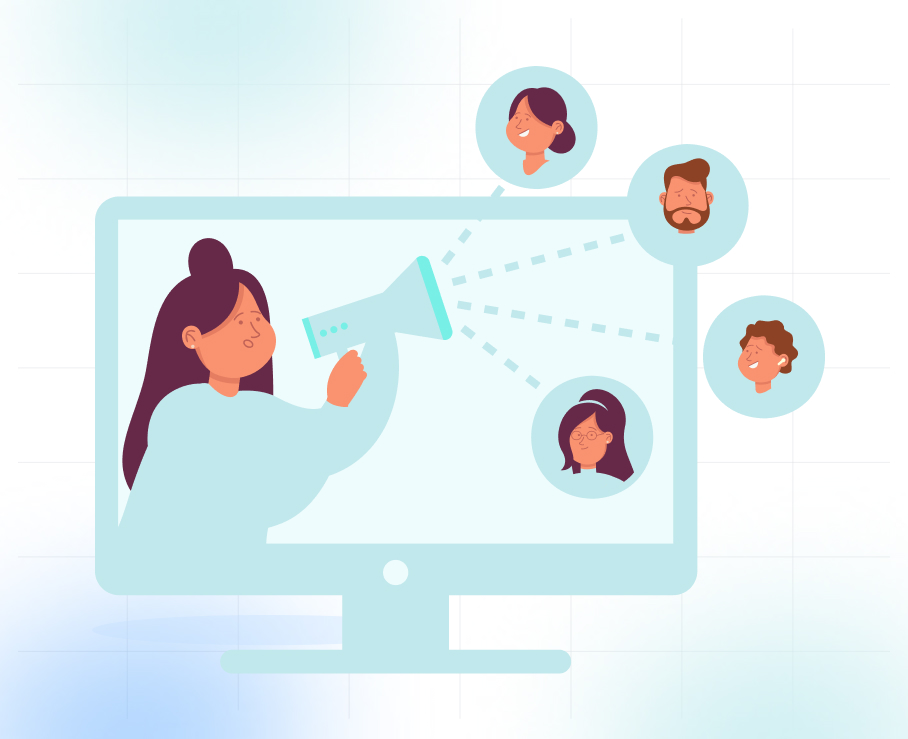
How to Find Leads for Your Business Online

Lead generation isn’t just a marketing buzzword; it’s the engine that drives business growth. And in today’s competitive landscape, it’s no longer optional. With over 1.27 million sales professionals in the U.S. and more than 1,800 leads generated per company each month, businesses that don’t have a clear lead generation strategy risk falling behind. For small businesses, the challenge isn’t ambition, it’s direction. How do you cut through the noise, reach the right people, and actually start conversations that turn into customers?
The answer starts with email. Unlike noisy feeds or cold outreach, email lets you speak directly to your prospects, with the right message, at the right time. When combined with thoughtful follow-ups and a smart cadence, it becomes your most reliable channel for building trust and generating leads consistently. In this blog, we’ll break down how small businesses can find leads online using practical, proven methods. From tools to tactics, everything here is designed to be simple, scalable, and aligned with how real buyers make decisions today.
What is Lead Generation for Your Business?
Lead generation is the process of attracting people who show interest in your products or services, gathering their contact information, and nurturing them into potential customers. In simpler terms, it's the act of getting people into your sales pipeline, where you can then work to convert them into paying customers.
Here’s why lead generation matters:

- Steady Stream of Prospects: Without a consistent lead flow, your business can't scale. Lead generation ensures a constant stream of interested prospects.
- Builds Relationships & Trust: Engaging with prospects early builds trust and helps you understand their needs, making them more likely to buy from you.
- Increases Revenue: By converting leads into paying customers, you increase your sales and grow your business.
Today, digital tools make it easier than ever to find leads in a focused, cost-effective way. You don’t need to rely on expensive ads or massive content campaigns. A well-structured email outreach strategy, backed by accurate data and clear messaging, can deliver consistent results while keeping your approach lean and targeted.
Read: Overcoming B2B Lead Generation Challenges and Solutions
Effective Ways to Find Leads for Your Business Online

Now, let's take a look at 10 powerful lead generation strategies for finding leads online. These methods combine various channels and tactics, giving you the flexibility to customize your approach to your business type and resources.
1. Email Marketing: Reach Directly to Your Leads
Email marketing remains one of the most powerful lead generation tools because it directly connects with your audience in a personal way. By sending targeted, relevant content to individuals who have opted into your communications, you can cultivate relationships and nurture leads over time. In fact, 89% of marketers rely on email marketing for generating leads. The ability to customize emails to specific stages of the buyer's journey makes this method incredibly effective.
How to Make It Work:
- Build Your Email List: Focus on quality over volume. Define the types of companies and decision-makers you want to reach using criteria like industry, revenue, team size, and buying stage. Then, build your list through targeted outreach, using intent signals, custom messaging, and clear next steps like offering a direct path to book an appointment. The goal isn’t just to collect contacts, but to build a pipeline of leads who are aligned, engaged, and ready to talk.
- Segment Your Audience: Instead of sending one-size-fits-all emails, segment your list based on demographics, interests, or past behaviors. This allows you to send personalized content, such as relevant blog posts or case studies.
- Craft Engaging Emails: Create compelling subject lines and content that resonate with your audience’s pain points. Always include a strong call to action (CTA) that guides them toward the next step, whether it’s booking an appointment, reading case studies, or making a purchase.
Read: How Investing in Email Marketing Can Transform Your Business and Boost ROI
2. Social Media Engagement: Build Relationships and Trust
Social media platforms like Facebook, LinkedIn, and Instagram provide businesses with a unique opportunity to interact directly with their audience. These platforms promote community, engagement, and trust, which are key to long-term customer relationships. It's not just about posting content; it's about engaging, responding, and building rapport with potential leads. Social media leads to more than just brand awareness. It actively drives traffic, conversions, and leads.
How to Make It Work:
- Engage with Your Audience: Respond to comments, ask questions, and start conversations around relevant topics. This engagement shows your audience that you're approachable and attentive to their needs.
- Create Shareable Content: Post content that educates, entertains, or solves problems, making it easy for followers to share with their own networks. Educational videos, infographics, or customer testimonials can work well here.
- Leverage Paid Ads: Use paid advertising on platforms like Facebook and LinkedIn to target specific audience segments based on location, interests, and behavior. Running hyper-targeted campaigns can help you reach potential customers with the most relevant offers.
- Use Hashtags & CTAs: Include relevant hashtags to increase the discoverability of your posts. Always add a CTA to encourage users to take the next step, like visiting your website, downloading a free resource, or reaching out to you.
Read: Guide to MSP Lead Generation & Appointment Setting: Tips and Tricks
3. Search Engine Optimization (SEO): Attract Organic Traffic
People aren’t just searching for products, they’re searching for solutions. A founder looking for a CRM isn’t typing “CRM” into Google. They’re typing, “how to stop leads from falling through the cracks” or “best tool to track follow-ups.” That’s where SEO comes in.
But forget everything you know about stuffing keywords or chasing rankings. Today, SEO is about earning attention by being genuinely useful. That means:
- Publishing content that solves specific problems your ideal customers face.
- Structuring your website so that visitors can find answers fast, even on mobile.
- Showing search engines you’re trustworthy, by getting cited by other trustworthy sites.
This isn’t a one-time project. It’s a system. You’re not chasing Google’s algorithm, you’re aligning your content with your buyers’ intent.
4. Run Paid Ads (PPC): Target High-Intent Leads
SEO is great for long-term growth. But what if you need leads next week? That’s where paid ads come in. Platforms like Google Ads and LinkedIn let you get your offer in front of high-intent users right when they’re looking for what you sell. But the trick isn’t just bidding higher. It’s messaging smarter, crafting campaigns that speak directly to pain points and solve problems instantly.
Instead of throwing money at broad keywords like “project management software,” imagine targeting:
- “Project management for remote creative teams”
- “Tools for client handoffs in agency workflows”
Now you’re showing up only when the fit is right, and the buyer is serious.
A good PPC strategy today looks like this:
- You run a search ad offering a free 5-day trial with a headline like “Still Using Spreadsheets? Try Our Visual Workflow Tool.”
- Someone clicks, lands on a clean landing page with one goal: get them to sign up. No distractions, just credibility boosters like reviews, logos, and one clear CTA.
- Even if they don’t convert? Retarget them with ads tailored to what they saw. “Still considering us? See how we helped X company cut task chaos by 70%.”
And here’s the key: don’t run and forget. The best-performing ads today are constantly tweaked based on live feedback. Copy changes, creativity gets refreshed, audiences evolve. You’re always learning.
5. Content Marketing: Create Valuable Blog Posts
Instead of broad blog content or SEO-driven posts, focus on real customer stories. Case studies help you show, not just tell, how your product or service delivers value. These assets give potential leads social proof and reduce friction in the buying journey.
How to Make It Work:
- Create Use-Case Based Narratives: Highlight different verticals or use cases where your solution made a measurable difference.
- Include Direct Quotes and ROI Stats: Prospects trust numbers. Keep the story crisp but data-backed.
- Use Them in Cadences: Add links to relevant case studies in your follow-up emails. “Here’s how we helped a business just like yours” is far more powerful than a product brochure.
6. Host Webinars and Live Sessions: Engage in Real-Time
Webinars provide an excellent platform for educating potential leads while building trust. These sessions allow businesses to showcase expertise, answer questions, and engage directly with an audience, making it easier to convert interested prospects into qualified leads.
How to Make It Work:
- Choose hyper-relevant topics. Skip the fluff and focus on what keeps your audience up at night. For example, if you’re in HR tech, host a live teardown of “Why 80% of onboarding fails—and what to do instead.”
- Make sign-ups frictionless, but intentional. Ask for names, company names, and emails. Enough to segment, but not enough to scare them away. You can gate the replay or offer bonus materials in exchange.
- Turn engagement into momentum. Don’t just thank them and vanish. After the session, follow up with tailored emails, share key takeaways, link to deeper resources, and invite them to take the next step, like scheduling a meeting. When done well, your email list becomes a community of interested leads who’ve already heard your voice and seen the value you bring.
Read: Pay Per Satisfaction – A Comprehensive Shift in Lead Generation Strategy
7. Offer Free Tools or Lead Magnets: Provide Value in Exchange for Contact Info
Offering something of value in exchange for contact information is a tried-and-true method for generating leads. Lead magnets such as eBooks, templates, or free trials attract prospects by solving immediate problems while positioning your business as a helpful resource.
How to Make It Work:
- Build Tools, Not Just PDFs: Think beyond eBooks, interactive ROI calculators, mini-audits, or even industry-specific swipe files tend to convert better. Bonus if your tool addresses a specific challenge your ICP faces in their day-to-day.
- Make the Exchange Feel Worth It: Your landing page should clearly explain what they’re getting, who it’s for, and why it’s worth their email. Use real copy, not vague fluff. “Download our template” doesn’t cut it, try “Plan your Q3 content calendar in 30 minutes with this pre-filled Notion board.”
- Keep the Experience Tight: Once someone opts in, don’t drop the ball. Trigger a clean onboarding email flow, introduce your brand, add value immediately, and nudge them toward deeper engagement (like a meeting or consultation).
Also Read: What Difference Can an Inside Sales Expert Make in My Current Sales Process?
8. Collaborate with Industry Influencers: Reach a Targeted Audience
Influencer marketing today isn’t about vanity metrics or mass reach, it’s about strategic alignment. The right creators already have the trust of the exact audience you’re trying to reach. When they vouch for you, it cuts through the noise. But for lead generation, you need more than a one-off shoutout, you need collaboration with intent.
How to Make It Work:
- Choose Relevance Over Reach: Skip the mega-influencers with generic audiences. Go for subject-matter creators who have built niche communities, think logistics experts on LinkedIn, sustainability advocates on YouTube, or procurement professionals on industry podcasts. These are the voices your prospects already listen to.
- Don’t Just Sponsor—Co-Create: Instead of handing over a brief and praying for magic, co-build content that’s deeply aligned with your audience’s problems. A how-to video using your product, a shared whitepaper, or a LinkedIn Live panel you co-host, these allow for organic mentions and lead-gen hooks.
- Track the Funnel, Not Just the Views: Add unique tracking links, use gated content, or offer influencer-specific landing pages. You’re not just borrowing attention, you’re converting it. Bonus: Follow up with everyone who signs up through that path with tailored emails referencing the content they came from.
9. Engage in Forum and Community Participation: Build Trust and Establish Authority
Forums aren’t just for casual browsing anymore, they’re where your future leads are actively looking for solutions. Whether it’s a niche Slack group, a Reddit thread, or a LinkedIn comment section, your presence there should be more than performative. Done right, it’s not just visibility, it’s soft acquisition.
How to Make It Count:
- Join the right conversations (not just the loud ones): Instead of dropping links on trending threads, get involved in discussions where your ideal customer is asking nuanced, real-life questions. Think, “How do I improve cold outreach reply rates without annoying people?” rather than “What’s a good CRM?”
- Be valuable before being visible: Share real tips, your own process, or even mistakes you’ve made. People trust those who teach openly without a sales pitch. If you do link to something, make it contextual, like a downloadable checklist or a tactical blog post that lives on your site with a newsletter sign-up nearby.
- Turn attention into action via email: When you start getting replies or direct messages, don’t let it end there. Create a “community follow-up” email, a short, thoughtful message that builds on the discussion and shares a helpful extra resource. It bridges the gap between forum chatter and becoming part of your audience.
10. Guest Post on Industry Blogs: Reach a New Audience
Guest blogging is still a high-trust way to build credibility—if you treat it like a platform, not a link farm. This isn’t about writing 700 words of SEO fluff. It’s about offering your sharpest thinking to someone else’s audience and inviting them into yours.
How to Make It Work Today:
- Pitch with precision: Don’t send the same guest post idea to ten blogs. Study each platform’s tone, audience needs, and gaps in their content. Then pitch something tailored, like “5 Cold Email Mistakes I Made (And Fixed)” to a B2B SaaS blog, or “How to Build an Email List Without Freebies” to a bootstrapper audience.
- Lead with frameworks, not features: Readers don’t want to hear what your tool does, they want a new way to think about their problem. Teach something they can apply immediately. Mention your brand or product as a “tool that works for us” rather than the centerpiece.
- Soft CTA to email, not product: Instead of pushing a sales page, invite readers to a related email series, resource vault, or even a short email conversation. Something like, “I created a follow-up checklist based on this post, email me if you want it.” That tiny opt-in is more powerful than a flashy CTA.
Lead generation today isn’t about being everywhere—it’s about being useful in the right places. While cold calls get ignored and ad fatigue is real, the inbox still gets attention. Email works because it respects the reader’s space and offers value on their terms.
At The Lead Market (TLM), we don’t just “run campaigns”, we architect them. From crafting human-first messaging to building targeted lists and optimizing send times, we handle the entire email journey with care. And when interest turns into intent, we don’t stop at a reply. Our appointment scheduling team steps in to secure qualified meetings on your calendar, so your sales team spends less time chasing and more time closing.
How a California MSP Franchise Scaled B2B Lead Generation with TLM
A managed service provider (MSP) franchise in Orange County, California, had the technical chops and a nationwide footprint, but struggled to feed their franchisees with qualified leads. Previous vendors offered little visibility, no control over lead quality, and generic campaigns that rarely delivered.
TLM changed that.
Starting with one territory in Maryland, we built a focused outreach plan: targeting local businesses with 10+ employees, identifying IT pain points, and sending personalized emails that got straight to the problem. No spray-and-pray, just smart, timely outreach.
When prospects showed interest, we didn’t let it sit, we booked meetings instantly, based on availability. And for the first time, the client could choose which leads to pursue. Full transparency. Real control.
In the first month, we booked 11 qualified meetings; in the second, seven more. The model proved itself. Now, our system supports over 100 of their 230+ locations across the U.S., consistently delivering around three high-quality leads per month per location. What started as a test became their go-to engine for predictable, scalable lead generation.
Read: The Case for Email Marketing | How Cold Calling is Killing Relationships
How TLM Can Drive Lead Generation for your Business
At TLM, we focus on helping businesses generate high-quality leads and convert them into long-term customers. With 9 years of experience in B2B lead generation and appointment scheduling, particularly with MSPs and other B2B sectors, we’ve developed a proven approach that delivers real, measurable results. We work with you to refine and optimize your lead generation process, ensuring that every step, from attracting prospects to converting them into loyal clients, drives meaningful growth for your business.
Here’s how TLM’s services can help your business generate more leads:
- Sales Qualified Leads (SQL): TLM specializes in generating high-quality sales leads that are ready for engagement. Through targeted campaigns, they ensure that only the most qualified prospects enter your sales pipeline, allowing you to focus your efforts on leads that are most likely to convert.
- Appointment Scheduling: One of the key challenges in sales is finding the right time to meet with prospects. TLM’s appointment scheduling services simplify this process by converting leads into confirmed meetings. This helps you make the best use of your sales team’s time, ensuring that they spend more time closing deals and less time chasing leads.
- Demand Generation: TLM excels at nurturing leads over time through multi-approach strategies, ensuring that prospects remain engaged and are ready to convert when the time is right. By building and maintaining a strong relationship with leads, TLM ensures that your business stays top of mind.
- Account-Based Marketing (ABM): With targeted campaigning and ABM, TLM focuses on high-value accounts that are most likely to benefit from your products or services. By personalizing outreach, TLM helps businesses connect with decision-makers in the right way, increasing the chances of conversion.
- Real-Time Dashboard & Customizable Email Scripts: TLM provides proprietary tools that enhance lead nurturing, including real-time dashboards for tracking leads and performance. Customizable email scripts help streamline communication, ensuring that your outreach is effective and personalized.
Lead generation is the cornerstone of any successful business. And the key is to combine multiple methods, customize them to your target audience, and continuously refine your approach based on data and results.
By adding these services by TLM into your lead generation strategy, you can improve the quality and efficiency of your sales efforts. Whether you're looking to attract more leads, nurture existing ones, or convert them into customers, TLM’s expertise can provide the support you need.






